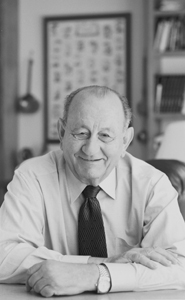 |
|
||
|
|
|||
B.U. Bridge is published by the Boston University Office of University Relations.
Alumni
profile
Carlos Samour: a pioneer in the field of polymer chemistry
By Brian Fitzgerald
In the late 1980s, Carlos Samour, as chairman of MacroChem Corporation,
focused on a technology that he felt had great promise: transdermal drug
delivery.
|
|
|
| BU Donor Carlos Samour (GRS'50). Photo by Kalman Zabarsky | |
His hunch was right -- researchers now recognize that the skin is an
excellent delivery route for drugs. And SEPA, a patented drug-absorption
agent whose development he oversaw, has proved a valuable alternative
to oral and intravenous drug application.
MacroChem, of Woburn, Mass., now concentrates its research on the areas
of sexual dysfunction, dermatological conditions, pain management, and
hormone replacement therapy. "We are anxiously awaiting the results
of several clinical studies on the transdermal delivery of drugs using
SEPA technology," says Samour (GRS'50), who last year returned to
the retirement he had abandoned in 1982 to start MacroChem.
In the mid-1980s, one of Samour's first successes in pharmaceutical research
was the development of a more effective cement that holds brace brackets
against teeth. For years, the dental profession had been concerned about
mottling patterns on the teeth of children who wore braces -- the traditional
cement being used was interacting with the fluoride added to city water
supplies. Samour patented and obtained FDA approval to market bracket
cement containing fluoride, which stopped the blotching patterns on the
teeth's enamel.
Samour's next important patent was SEPA (soft enhancement of percutaneous
absorption), which is composed of carbon, hydrogen, and oxygen and delivers
drugs into the bloodstream at a constant rate -- bypassing the stomach
and the liver, where irritation and problems of degradation can occur.
"One of the MacroChem drugs that uses SEPA is Topiglan, for the treatment
of impotence in men," says Samour. "It is being tested clinically
with good results so far." Impotence affects more than 30 million
men in the United States, and most cases are caused by atherosclerosis
or diabetes, which restrict blood flow to the penis. The majority of the
oral drugs currently marketed or under development to treat it are vasodilators
-- compounds that attempt to dilate disease-constricted penile blood vessels.
However, patients with a history of vascular disease of the heart or brain
may be at risk if the anti-impotence vasodilators affect arteries and
veins elsewhere in the body, or if they intensify the effects of nitrate-containing
drugs used to treat symptoms of heart disease.
"Drugs taken orally, such as Viagra, are distributed throughout the
body," says Samour. "But Topiglan is put on the penis and acts
almost exclusively on penile blood vessels. It doesn't interact with the
systemic effects of nitrate drugs."
In a Phase 2 trial at the Boston University School of Medicine, Topiglan
outperformed a placebo six to one in patients with moderate to severe
vascular-caused impotence. Topiglan is now in a Phase 3 protocol trial,
the last phase of drug development before FDA review.
In appreciation for his education at BU, where he earned a Ph.D. in organic
chemistry, Samour recently donated more than half a million dollars in
MacroChem stock to the Samour Family Trust Fund, which he established
in 1986 to enhance relationships among researchers at the College and
Graduate School of Arts and Sciences, the College of Engineering, and
the School of Medicine, and to improve University-industry relations.
Samour also donated $10,000 in MacroChem stock to the new Arts and Sciences
Endowment Fund, whose income will support faculty professorships, fellowships
for graduate students, and undergraduate programs. "I'm very excited
about the fund," Samour says. "The Dean's Advisory Council for
the Arts and Sciences enthusiastically supported this idea, and a matching
gift program has been created for this important new venture."
Samour, who received an Alumni Award for Distinguished Service to Alma
Mater in 1994, was born in El Salvador in 1920. In 1942 he received his
B.A. and in 1944 his M.A. in chemistry from American University of Beirut.
He received his M.S. in organic chemistry from MIT in 1947. After earning
his Ph.D. from GRS in 1950, he was a postdoctoral research fellow at Boston
University until 1952. He worked as a research chemist for the Kendall
Company for five years, and was then appointed director of its Theodore
Clark Laboratory. In 1973, he was promoted to director of the company's
corporate Lexington Research Laboratory. Samour formed MacroChem in 1982.
![]()
12
October 2001
Boston University
Office of University Relations
